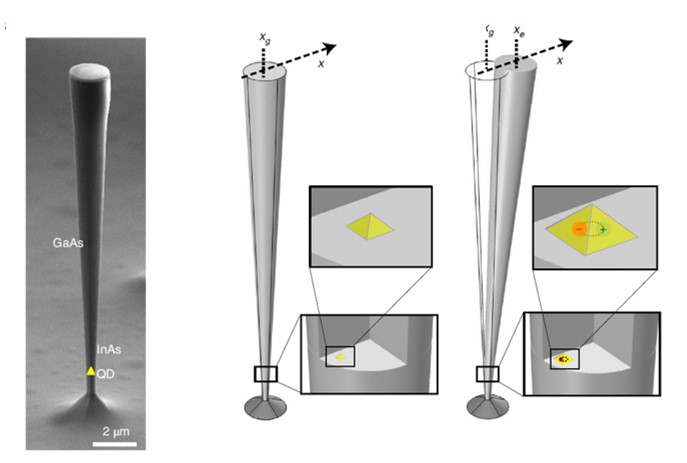A Quantum Dot Drives a Microresonator
Observing the quantumness of nature remains elusive in the everyday life. This is largely due to a phenomenon called decoherence, which explains that the properties of quantum systems are diluted when interacting with large objects.
By demonstrating the actuation of a mechanical micro-wire by optical manipulation of the state of an artificial atom, a team bringing together physicists from the Néel Institute (CNRS, Université Grenoble Alpes), IRIG (CEA, Université Grenoble Alpes), ENS Lyon, Université de Campinas (Brésil) and the University of Nottingham (UK) is taking an important step forward in the design of an interface allowing the transfer of quantum information from single microscopic systems to macroscopic ones.
The device developed by the team of researchers consists of a 18 µm-long conical semiconductor micro-wire of gallium arsenide, at the base of which an indium arsenide quantum dot (QD) is implanted, offset relative to to the axis of symmetry (see Fig. (a – b)). The excited state of this type of QD corresponds to the formation of an electron-hole pair, also called an exciton. The presence of this exciton in the QD modifies its effective volume (see Fig. (C)), which causes a significant modification of the stress field through the microwire. Since the QD is outside the axis of symmetry, this stress induces a deflection, which is the expected result.
Experimentally, the team uses pulses from a laser tuned to the quantum dot transition to periodically form these excitons. The resulting micro-wire vibration is detected synchronously by laser interferometry. This work is published in the journal Nature Nanotechnology.
One of the major challenges faced by scientists to achieve these results is related to the intervention of multiple degrees of freedom inherent to the macroscopic nature of the micro-wire and its coupling to the QD, which tend to dissipate quantum signatures. Thus, the experiment had to be repeated a large number of times in order to average these effects, which requires an extremely stable experimental setup. If significant progress remains necessary in the perspective of making this concept an interface allowing the transfer of non-classical quantum signatures onto robust macroscopic systems, this proof of principle opens the way and lays the foundations for an approach that appears to be very promising in the context of the deployment of quantum technologies.
Press coverage:
Welt der Physik: link
Wissenschaft Aktuell: link
CNRS: link
Contact: Jean-Philippe Poizat


Recent Comments